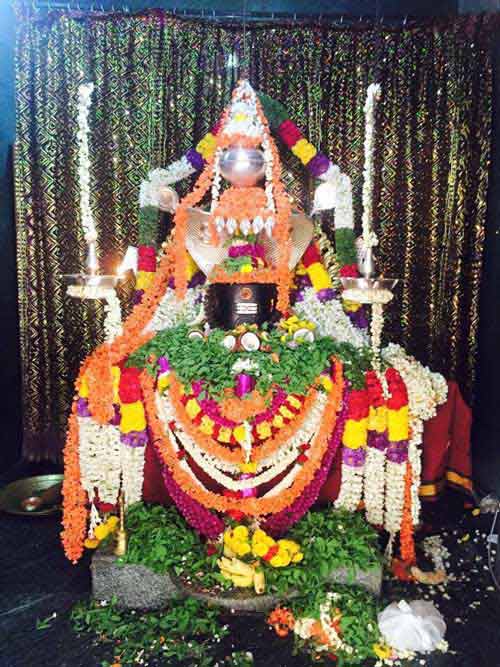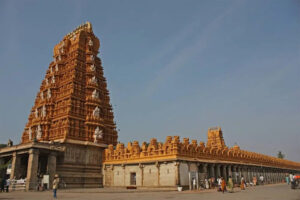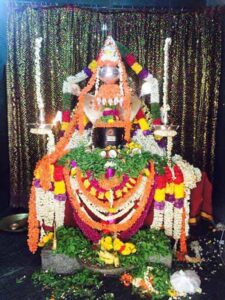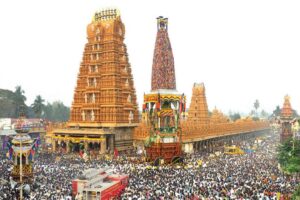Srikanteshwara Temple Nanjangud:
The ancient Shiva-focused Nanjundeshwara Temple, also known as Srikanteshwara Temple, is located in the Indian state of Karnataka’s Hindu pilgrimage town of Nanjangud. Situated on the right bank of the Kapila River, which is a tributary of the Kaveri River, lies the location. “Dakshina Prayaga ” or “Prayag of South ” are other names for Nanjanagudu.
In Kannada, nanju means “to poison”. The settlement was christened Nanjanagudu, which translates to “the abode of the god Nanjundeshwara.” The name Nanjundeshwara means “the God who Drank the Poison.”
Thousands of devotees flock to the temple for its annual Dodda Jaathre celebration. During the fair’s festivities, devotees pull five vibrant chariots along a route known as the ratha beedi. Nanjundeshwara Temple and Parasurama Temple are close by.
Devarajammanni, the queen of Mysore monarch Krishnaraja Wadiyar III, constructed the temple’s gopuram, or gateway tower, which stands nine stories tall and has a large façade.
Nanjangud Temple History:
The Shiva Purana mentions Nanjungud as Sri Garalapuri. The fabled sacred site is supposed to be Shiva’s residence in southern India. The deity appeared at the request of his followers, the Devas, and the sage Narada; it is also known as “Dakshina Kasi.” Brahma and Vishnu bestowed onto the demon Keshi a boon that prevented them from killing him. He started to bother the people, the Devas, and the sages, thinking that he was practically eternal with this gift. Finally, Shiva heard Narada and the Devas’ pleas for everyone’s salvation. He killed Keshi when he showed up in Garalapuri Sri Kshetra, which is now Nanjungud.
He also promised that his Ansh, a portion of his divine nature, would always be here, blessing people, and that this location would now be known as a papa vinashini, or “remover of sins.” Every person who prays to Lord Srikanteshwara or Nanjundeshwara (Shiva) of Nanjungud will be blessed by the gods and be free of sins after taking a bath in the sacred Kabini River.
Sage Parashuram sought to atone for his sins from “Matru Hatya,” or his mother’s murder, after killing her on his father Sage Jamadagni’s command. He went to Garalapuri (Nanjangud) on Narada’s recommendation and prayed to Sri Nanjundeshwara Swamy. When Shiva showed up, he was told to construct a mantapa and offer prayers to the Shivlinga. The Shivlinga’s tip started to bleed when Parashuram accidentally struck it with his parashu (axe) as he was using it to clear the shrubs . “I have committed another unforgivable sin; only by killing myself shall I be relieved from all my sins,” the deeply repentant Sage Parashuram declared as he got ready to commit suicide.
When Shiva showed up, he blessed Sage Parashuram and instructed him to cover the Shivlinga with wet mud (Sri Nanjangud’s mud having great healing properties). The Shivlinga ceased to bleed. Parashuram was advised by Lord Shiva to construct the mantapa and carry out his penance. At last, Sage Parashuram received a blessing of immortality together with absolution from all his misdeeds.
Shiva’s consort, the goddess Parvati, requested to see this sacred site, so he took her to Garalapuri Nanjangud. A gemstone bead (mani) tumbled out of her crown and into the Kabini River when she knelt to touch the water. “Devi, up until now, the place has had my divine blessings and presence; from this moment on, it shall have your presence, grace, and blessings too,” said a delighted Lord Shiva. Another name for it will be Dakshina Manikarnika Ghat.
King Tipu Sultan’s royal elephant went blind during his reign. Tipu sent the elephant to the Nanjundeshwara Swamy Temple and carried out 48 days of rites as instructed by his minister, Sri Poornayya. The elephant’s vision was restored on day forty-eight. As a thank you to Sri Nanjundeshwara Swamy, Tipu Sultan presented the emerald green Shivlinga and addressed Lord Shiva as “Hakim Nanjunda” (healer).
Srikanteshwara Temple Nanjangud Timings:
The timings of nanjangud timings is 06:00 am – 01:00 pm
04:00 pm – 08:30 pm
What are the different types of Abhishekam available at Nanjangud Temple?
Usha kala Abhishekam – 6:30 AM
Pratha kala Abhishekam – 9:00 AM
Sangama kala Abhishekam – 11:00 AM
Madhyana kala Abhishekam – 12:00 PM
Pradoshkala Abhishekam – 6:30 PM
Ekanta kala Abhishekam – 8:00 PM
Nanjangud Temple Pooja details:
Abhisheka Pooja – 07:30 am to 06:30 pm
Pooja (Opening) – 07:35 am to 06:44 pm
Pooja Price details:
1 Astottara for One – Rs. 50
2 Dodda Basaveshwaraswamy Abhisheka – Rs.200
3 Ekadashi Rudhrabhisheka – Rs.1500
4 Ekavara Rudrabhisheka – Rs.1000
5 Kivi Chuchuva Kanike – Rs.150
6 Namakarana Kanike – Rs.150
7 Panchamrutha Abhisheka – Rs.150
8 Shalyanya Abhisheka – Rs.200
9 Thrishathi – Rs.100
10 Tulabhara Kanike – Rs.50
11 Tulasi Sahasranama – Rs.250
12 Vastradharane Kanike – Rs.30
Nanjangud Temple Official Website: https://itms.kar.nic.in/
Festivals celebrated at Nanjangud Temple:
Thousands of devotees attend the temple’s Dodda Jaathre festival. The fair’s festivities include five colourful chariots drawn by devotees down a path known as the ratha beedi.
Usually held in November or December, Chikkajathre is a small festival in which devotees pull three chariots.
Sri Srikanteshwara Jayanthi: On Sri Srikanteshwara Jayanthi, there will be a parade of eleven miniature chariots.
Skandha (Subramanya) Shashti: On Skandha (Subramanya) Shashti, devotees draw a chariot containing an idol of Lord Subramanya.
Ashadamasa will mark the celebration of Girija Kalyana.
Kartheekamasa will mark the celebration of Lakshadeepotsava.
Nanjangud Temple Sevas online booking:
To book sevas at Nanjangud Temple or any other temple, you can follow these general steps:
Visit the Official Website: Check if Nanjangud Temple has an official website. Most temples provide information about sevas, darshans, and other services on their websites.
https://itms.kar.nic.in/hrcehome/eservices_search.php?activity=eservices&tid=7&catcode=6
How to reach nanjangud temple
By Air:
The Mysore airport is the one closest to the temple.
By Rail:
The Nanjangud Railway Station is the railway station nearest to the shrine.
By Road:
The distance between the temple and Mysore is 23 km. There are regular buses that leave from Chamarajanagar and Mysore.
Srikanteshwara Temple Nanjangud Location:
Rastrapathi Road, Nanjangud, Karnataka 571301
Nanjangud Temple distance:
Bangalore to Nanjangud Temple distance – 2 hr 57 min (170.0 km) via NH 275
Mysore to Nanjangud Temple distance – 35 min (23.6 km) via NH-150A
Srirangapatna to Nanjangud distance – 54 min (44.6 km) via NH 275K and NH 766
nanjangud temple to melkote distance – 1 hr 49 min (81.5 km) via NH 766 and NH-150A
nanjangud temple to sringeri distance – 6 hr 36 min (276.4 km) via NH 373
Nanjangud Temple Dress Code:
Nanjangud Temple maintains a dress code to uphold the sanctity of the sacred space. Visitors are encouraged to wear modest attire covering shoulders and knees, with traditional Indian clothing appreciated. Removing footwear, avoiding tight or revealing clothes, and showing respect through appropriate dressing are integral aspects of the temple’s dress guidelines.
What is the best time to visit Nanjangud temple?
The best time to visit is October
Nanjangud Temple contact number – 08221226245
Srikanteshwara Temple Nanjangud Photos:




